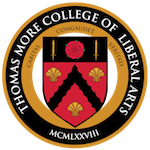By Brendan McDonald ’25
In the first week of fall, near the feast of the North American Martyrs in the traditional calendar, over fifty Thomas More College students embarked on the Pilgrimage for Restoration, a sixty-two-mile journey from the banks of Lake George to the spot where St. René Goupîl was martyred. The Pilgrimage is in its twenty-ninth year and comprises over 800 pilgrims, including priests, religious, and laymen. Each year, these pilgrims set out for the National Shrine of the North American Martyrs in Auriesville, NY.
The expedition is an annual tradition for Thomas More students. Over half of the College’s student body departs after classes on Thursday to return Sunday night after a whole weekend of walking, praying, singing, and bolstering each others’ spirits along the difficult journey. “For TMC, pilgrimage is a journey not just for the individual pilgrim but for the College as a whole,” Marie Vyleta ’25 commented.

For the second time, Miss Vyleta—along with classmate Liam Beecher ’25—organized the transportation of TMC students from Merrimack, NH to Lake George, NY. For Miss Vyleta and Mr. Beecher, preparation began in late summer, with the selection of a chaplain and leaders for each brigade (groups of roughly twenty-five people that march together on the road). Once the semester begins, the majority of the student organizers’ task is communicating details to students through announcements, emails, and meetings.
The work requires many hours attending to administrative details behind the scenes. The effort, however, is worth it: “The long car ride, days of walking and singing, and the evenings in the camp, eating soup huddled on the cold ground, have made some of the fondest memories I have with my fellow students,” Miss Vyleta said. “We return with a greater love and appreciation for each other and a deeper sense of common purpose, both as students and as children of God.”
“When we reached the end, it was incredible to look back and see what we had done through Christ—how it was entirely Him. It made it easier to see His grace in the rest of my life.”
– Madeline Conner ’28
As many might suspect, a central challenge of the pilgrimage is the physical strain of walking an average of twenty miles per day. That physical pressure also creates mental and spiritual challenges, resulting in three days of discomfort. Yet, as James Greydanus ’27 put it, suffering makes the pilgrim more receptive to God and spiritual growth. While there is “hardly a moment’s peace,” the dual physical and mental strain “serves to put you in a spiritually receptive state. This receptivity builds over the three days and culminates in the arrival at the Shrine, which moves many to tears,” he observed.
Madeline Conner ’28 expressed a similar sentiment. “As we walked,” she found, “singing and praying and shouting and crying together, one prayer we would chant was ‘I can do all things through Christ who strengthens me.’ When we reached the end, it was incredible to look back and see what we had done through Christ—how it was entirely Him. It made it easier to see His grace in the rest of my life.” Description fails to capture the experience: “There was nothing people could have said beforehand that would have made me know that strength, mercy, and grace so intimately.”

The nature of pilgrimage requires many volunteers fulfilling different roles. “Brigadiers” lead the walking stretches of the day and receive instructions during breaks while everyone rests. “Safeties” take turns breaking up traffic to allow each brigade to cross intersections. Van drivers sacrifice hours of sleep traveling forward to stopping points. “We are very fortunate at TMC to have many eager and generous volunteers,” Miss Vyleta said, which makes the pilgrimage an “easy and shared burden.”
The various roles reveal various perspectives. One TMC pilgrim, Margaret Six ’25, was on the College’s tent crew, in charge of cleaning up campsites after the brigades had departed. The team then drives to the next campsite and reassembles the tents. “You give them a small comfort at the end of a long, hard day,” she reflected. “And I think it makes it a little bit easier for them to bear their sufferings well.”
“We return with a greater love and appreciation for each other and a deeper sense of common purpose, both as students and as children of God.”
– Marie Vyleta ’25
Miss Six also observed that the nature of pilgrimage symbolizes life itself. “At first, man is young and youthful and full of vigor and excitement about the world,” she said, “but you reach a sort of middle age, as it were, where it’s just hard, and there was pain before and there’s pain ahead of you, but you push through by the grace of God and the help of others.”
“As our motto says,” Miss Vyleta remarked in conclusion, “‘charity rejoices in the truth,’ and I have rarely seen my schoolmates as full of joy and love for one another as when they have arrived together at the Shrine and see with renewed hearts and minds the ground on which the martyrs died for the truth of the Faith they loved.”
For further reading:
